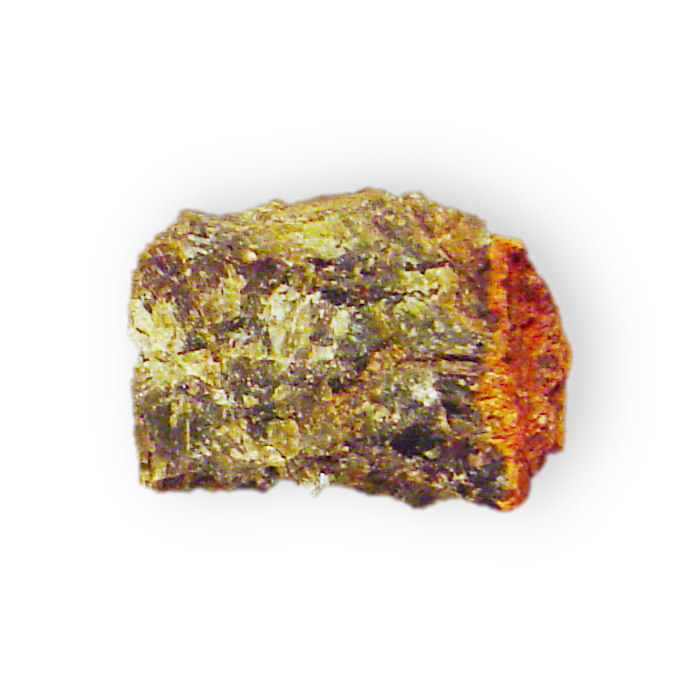- Enstatite
Infobox mineral
name = Enstatite
category =Silicate mineral
boxwidth =
boxbgcolor =

imagesize =
caption =
formula = Mg2Si2O6
molweight =
color = White, grey, green, yellow or brown - colorless in thin section.
habit = Lamellar, fibrous, or massive.
system =Orthorhombic
twinning = Simple and lamellar on [100]
cleavage = Good/distinct on [210]
fracture = Uneven
mohs = 5 to 6
luster = Pearly on cleavage
refractive = nα = 1.650 - 1.668 nβ = 1.652 - 1.673 nγ = 1.659 - 1.679
opticalprop = Biaxial (+) 2 V = 55 - 90
birefringence = δ = 0.009 - 0.011
pleochroism = none
streak =
gravity = 3.2 - 3.3
density =
melt =
fusibility =
diagnostic =
solubility =
diaphaneity = Translucent to opaque
other =
references = [http://rruff.geo.arizona.edu/doclib/hom/enstatite.pdf Handbook of Mineralogy] [http://www.mindat.org/min-1384.html Mindat]Enstatite is the magnesium endmember of the
pyroxene silicate mineral series enstatite (MgSiO3) - ferrosilite (FeSiO3). The magnesium rich members of thesolid solution series are common rock-formingmineral s found inigneous and metamorphic rocks. The intermediate composition, (Mg,Fe)SiO3, has historically been known ashypersthene , although this name has been formally abandoned and replaced by orthopyroxene. When determined petrographically or chemicaly the composition is given as relative proportions of enstatite (En) and ferrosilite (Fs) (e.g., En80Fs20).Weathered enstatite with a small amount of iron takes on a submetallic luster and a bronze-like color. This material is termed
bronzite , although it is more correctly called altered enstatite.Most natural
crystal s areorthorhombic (space group P"bca") although three polymorphs are known. The high temperature, low pressure polymorphs are protoenstatite and protoferrosilite (also orthorhombic, space group P"bcn") while the low temperature forms, clinoenstatite and clinoferrosilite, aremonoclinic (space group P2"1/c").Bronzite and hypersthene were known long before enstatite, which was first described by G. A. Kenngott in 1855.
An emerald-green variety of enstatite is called chrome-enstatite and is cut as a
gemstone . The green color is caused by traces ofchromium , hence the varietal name. In addition, bronzite is also sometimes used as a gemstone.Identification
Enstatite and the other orthorhombic pyroxenes are distinguished from those of the monoclinic series by their optical characteristics, such as straight extinction, much weaker
double refraction and strongerpleochroism . They also have a prismatic cleavage that is perfect in two directions at 90 degrees. Enstatite is white, gray, greenish or brown in color; itshardness is 5 - 6 on theMohs scale , and itsspecific gravity is 3.2 - 3.3.Occurrence
Isolated crystals are rare, but orthopyroxene is an essential constituent of various types of
igneous rock s andmetamorphic rock s. Magnesian orthopyroxene occurs in plutonic rocks such asgabbro (norite) anddiorite . It may form small idiomorphic phenocrysts and also groundmass grains in volcanic rocks such asbasalt ,andesite , anddacite .Enstatite, close to En90Fs10 in composition, is an essential mineral in typical
peridotite andpyroxenite of theEarth's mantle .Xenolith s of peridotite are common inkimberlite and in somebasalt . Measurements of thecalcium ,aluminum , andchromium contents of enstatite in these xenoliths have been crucial in reconstructing the depths from which the xenoliths were plucked by the ascending magmas.Orthopyroxene is an important constituent of some metamorphic rocks such as
granulite . Orthopyroxene near pure enstatite in composition occurs in some metamorphosedserpentine s. Large crystals, a foot in length and mostly altered tosteatite , were found in 1874 in theapatite veins traversingmica -schist andhornblende -schist at the apatite mine of Kjorrestad, near Brevig in southernNorway .Enstatite is a common mineral in meteorites.
Crystal s have been found in stony and ironmeteorite s, including one that fell at Breitenhach in the Erzgebirge,Bohemia . In some meteorites, together witholivine it forms the bulk of the material; it can occur in small spherical masses, orchondrule s, with an internal radiated structure.Enstatite in Space
Enstatite is one of the few silicate minerals that have been observed in crystalline form outside our Solar System, particularly around evolved stars and
Planetary Nebulae such asNGC 6302 . Enstatite is thought to be one of the early stages for the formation of crystalline silicates in space and many correlations have been noted between the occurrence of the mineral and the structure of the object around which it has been observed.Fact|date=September 2008References
* Deer, W. A., Howie, R. A., and Zussman, J. (1992). "An introduction to the rock-forming minerals (2nd ed.)". Harlow: Longman ISBN 0-582-30094-0
*
Wikimedia Foundation. 2010.
